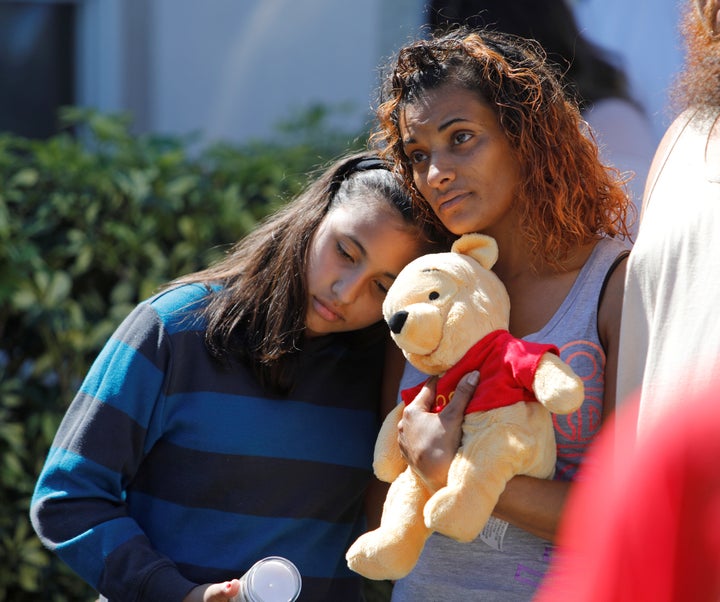
On Thursday, in response to a deadly school shooting in Florida that left at least 17 dead, President Donald Trump said he would work with state leaders to prioritize school safety.
Trump was vague on specifics, but in the aftermath of school shootings, legislators usually call for more school cops and a beefing up of school security measures.
But research shows that it might be a misguided response. There is conflicting research about whether or not cops actually make schools safer, and advocacy groups say school-based police officers can help funnel vulnerable students into the criminal justice system at young ages.
After the Columbine High School shooting in 1999, the number of police officers based in schools ballooned. Only 10 percent of public schools employed police officers in 1997, but by 2014, this number had increased to 30 percent. Similarly, after the Sandy Hook Elementary School massacre, the Obama administration funded a grant program providing federal dollars to schools to hire cops.
Some research has shown that school cops can exacerbate the school-to-prison pipeline, a phenomenon in which students ― often those of color ― are pushed out of school and into the criminal justice system.
A 2013 report from the Congressional Research Service, produced as a response to the Sandy Hook shooting, indicated that children who had cops in schools might be more likely to face arrest for minor offenses. But per the report, other studies showed that schools with cops on campus are more likely to have emergency plans in place and receive regular safety checks. Research has not yet indicated that having a cop on campus decreases the possibility of a shooting, although there have been a few high-profile instances of school cops successfully foiling armed intruders.
“The body of research on the effectiveness of SRO [school resource officer] programs is noticeably limited, and the research that is available draws conflicting conclusions about whether SRO programs are effective at reducing school violence. In addition, the body of research on the effectiveness of SROs does not address whether their presence in schools has deterred mass shootings,” says the report.
Cops on campus have been shown to have “mixed effectiveness with regards to school safety,” Jason Nance, a University of Florida professor whose work looks at the impact of cops on campus, told HuffPost in 2016.
“Are schools safer because we have more police officers? There are big questions about that,” Nance said in an email on Friday. “And we don’t talk enough about the downsides of having more police officers in schools, such as more school-based arrests for matters that should be handled in other ways.”
Indeed, Marjory Stoneman Douglas High School in Parkland, Florida ― the site of Wednesday’s school shooting ― employed an armed guard. However, the officer never encountered the shooter, according to Broward County Sheriff Scott Israel.
“Are schools safer because we have more police officers? There are big questions about that.”
- Jason Nance, University of Florida
The organization that helps train some school police officers, the National Association of School Resource Officers (NASRO), has in the past touted their ability to stop school shootings.
“After Sandy Hook occurred, our phones rang off the hook as a matter of fact, our training has doubled this past year,” Mo Canady, executive director of the group, previously said in a press release. “What we train them to do is not sit or stand and wait for help but to be able to address the incident immediately and find the shooter and end the situation.”
But when police officers are stationed in schools, some studies show it increases the likelihood that students will be criminalized for adolescent misbehavior by way of school-based arrests or referrals to outside law enforcement. These experiences can have lasting consequences for children.
One 2009 study showed that schools with cops had more arrests for low-level offenses like disorderly conduct than schools without them. Nance’s research has found that schools with police had more referrals to local law enforcement for things like alcohol possession, vandalism and fights without a weapon.
Having cops in school may also increase the possibility for police brutality. While NASRO helps provide specific training for school-based police officers working with kids, in many places, this training isn’t required. A previous HuffPost investigation found that between 2011 and 2016, there were at least 87 incidents of school police using stun guns on kids for a range of behaviors.
And when students get arrested, different demographic groups don’t get arrested in equal numbers. Black children, who only represented 16 percent of school-aged children in 2012, were arrested at school 31 percent of the time, according to previous data from the U.S. Department of Education.
These experiences can have a lasting effect. Students involved with the criminal justice system are more likely to drop out of school or be unemployed later in life.
Yet in times of school violence, communities often look to increase police presence on campus, says Nance.
“Putting more police officers in schools is something tangible that school authorities can do to demonstrate to a worried constituency that they are trying to make schools safer,” he said. “However, so far we don’t have any hard evidence that more police officers in schools make schools safer.”
